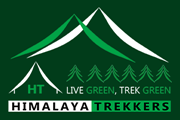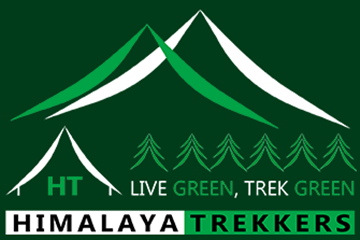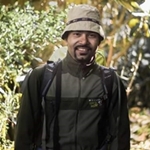Trekking gear or equipment are a necessity on any multi-day trekking programme in the Himalayas. Be you a first-timer or a seasoned trekker, every time you ask a common question to yourself before a trekking tour, “Do I have all the required trekking gears?” If the answer is yes (assuming you know your own stuff), then you are done and need not continue to read this blog. However, if the answer is no, then stick to this article. This may also be useful for you to create a strategy for what gear to buy, even if you are not new to Himalayan trekking.
Here, I am assuming that you are joining an organised trekking tour, which will take care of your camping logistics like tents, sleeping bags, mattresses, cooking utensils, and so on. At HT we provide these items in our organised treks. So our focus is on your personal trekking gear, whether to rent or buy?
There are surely vested interests and myths behind this topic floated on the internet, and you need to understand, estimate, and then take a well-informed decision about whether to rent or purchase a particular piece of trekking gear.
What are your key trekking gears of primary importance?
No matter how long your list of things to carry on a trek is, the following are the key elements of your gear list: These are so not only due to your safety but for comfort also. These will safeguard you during a trek against weather odds in the Himalayas. You wouldn’t like to bet on the following items:
- Your 3-layers of clothing (a must on the mountains between ~3000 m/10000 ft to ~6000 m/20000 ft):
- Sleeping bag (generally it is included in the package by your tour operator, like we do in our treks)
- Your trekking shoes/boots
- A rucksack/backpack with a raincover
Check out our guide on what you should look for when buying a trekking gear.
At the same time, there would be people going on easy to moderate treks for the first time, unsure whether they would trek again or not. From my experience working for more than 12 years as a tour operator, I have seen many groups return to the Himalayas again and again.
If you are a gear geek or if budget is not a constraint, then just do your research and buy the gear that suits you. You need not bother anytime soon with any future backpacking, hiking, or trekking trip anywhere around the globe.
At the same time, many among us may not have the budget required. Besides that, like many other fellow Indians, I am also price conscious in general and try to see the potential return on investment, cost effectiveness, or simply put, value for money. So let’s take a deeper look:
Note: 1 m = 3.28 ft. Here the mentioned figures are to give you a general idea and not exactly a conversion.
Understanding 3 -layers of clothing in trekking:
Remember that there is no substitute for quality trekking gear, which is generally light-weight to give you much needed relief on the mountains.
- Base layer (moisture-wicking layer): A quick-dry base layer (Dry-fit t-shirt, half or full sleeves): Isn ‘t we all have a few of these gym/running t-shirts nowadays, ain’t we? For the bottom layer, it’s better to get a similar dry-fit trouser, which is usually water repellent as well.
- Mid layer (warm clothing): Usually a warm jacket (Synthetic/Hollow fibre/Fleece or a Down jacket; you may use a combination of layers as well) — which constructs your middle layer. For the bottom layer, you may use a thermal or woolly cotton inner pant.
- Outer layer (weather proofing): a windproof and waterproof jacket with a hood for high altitude treks at or above 4500 m – 15000 ft or a poncho or raincoat (upper and lower) for treks up to 4000 m – 13000 ft.
I would always prefer to buy the above layers separately. There are products named 3 in 1 Jacket, Waterproof Warm Jacket, or Snow Hiking Jacket, which are apparently tempting. Just don’t buy such products, but get your layers separately. Thank me later for convenient and wider usages 😀
When you purchase a gear, invest in good products
There are many advantages to buying good quality gear, and the main ones are:
Trusted products from reputed brands maintain safety and other product specification standards. These products are quite likely to withstand the conditions they are rated and designed for.
You may reuse a good product on different occasions; e.g., a windproof and waterproof jacket can be very handy during monsoon days, and your warm fleece can steal the show in the autumn or winter.
Wider reuse of products in different actions. You can use these for trekking, hiking, backpacking, motorcycling, bicycling, or even in your daily life, depending upon where you live.
Quality products are often lightweight, which is a key characteristic of good trekking gear. Every gram on the mountain matters.
The takeaway is that you shouldn’t buy an item because of its lower price tag. This may just work for your next trip, but it is not useful in the long run for different types of travel if you intend to.
How much does it cost to get all the essential gear?
So in Indian market, both retail and online you will get these items (you only buy from trusted and reputed brands in outdoor industry):
Base layer:
1 or 2 dry fit T-shirts, ₹ 1000 for one. You also get non-branded products that are available in the sports market in your locality, like those synthetic, light-weight perforated jerseys (₹ 500 a piece).
Mid layer:
Either you can use a good warm synthetic jacket, or a mountain quality fleece jacket which can keep you toasty between 5° C to 10° C. A decent and tested reputed brand jacket in Indian market will be between ₹ 3000 – 5000. There is also the choice of more expensive down jackets. A 800 fill power down is recommended considering advance and wide use.
Outer layer:
This can be a game changer or a lifesaver on mountains. Often, you will get windy days on mountains. The windproof layer cuts the wind at the outer layer so you don’t get wind chill. On top of that, always prepare for an unexpected drizzle, rain, downpour, snow, or hail. Yes, you need a waterproof jacket. Always buy one that comes with a hood. ₹ 3000 – 6000.
When you put all your layers together, you are comfortable at 0°C, maybe to your limit at -5°C. If you need more warmth, just put another additional layer on top, e.g., a sweater, a hoody, or a pullover.
For bottom usually a quick dry pant is good enough which are also water repellent. If you are going in colder places below freezing then consider carrying a thermal for bottoms. ₹ 1500 to 2500.
Adding your clothing part, it comes around ₹ 10,000.
Trekking shoes:
₹ 4000 – 6000. We have tested shoes which are priced around ₹ 4000 in the Indian market, those are waterproof to an extent, mid ankle, have a decent traction sole, and are pretty light. You can comfortably use these up to 4500 m – 15000 ft or probably up to 5000 m. At retail stores, the executives may try to sell you more expensive products, but now you know that’s what you need.
A rucksack:
Without this, you can’t even go till base camp carrying all your stuff. Gone are the days of strollers and suitcases. Buy a 50-liter backpack priced between ₹ 2000 – 5000 that can serve you not only on a trekking trip but on your usual family travel and backpacking mixed tours, etc.
Quite a hefty budget, do you think? It’s coming between ₹ 15,000 and ₹ 20,000, depending mainly upon quality.
A note on the sleeping bag:
As only a handful of treks in the Indian Himalayas are Tea-House or homestay/lodge style, the majority of the treks here will require a sleeping bag for a comfortable night’s sleep. Seasoned trekkers going up to 6000 m or 20000 ft and camping above 5000 m – 16500 ft should have your personal sleeping bag for your own warmth and safety. Buy one that is rated and suited for the expected temperature range on your high altitude trek.
Although, as already mentioned, for our organised treks, we provide a sleeping bag in the package.
This is my first time trekking in the Himalayas. Do I have to buy so many gears and spend so much money? Is it really essential?
No, not at all. As this is your first time, it’s safe to assume that you are probably going up to around 13000 ft – 4000 m, on an easy or easy to moderate trek, which is usually a soft trek im nature. So we will see what alternatives we have rather than buying everything.
Reuse your existing items:
We all have some sort of warm or winter clothing back home. For people of north India, you already should have warm enough clothing for your winters. Even if we are in the south, west, or east of India, most likely we will have clothing to deal with a temperature of at least 10°C, kept for those coldest days. Just put on one or two additional layers (layering up is the mantra), e.g., your pullover, sweater, hoodie, or thermal that you already have.
Many of us will have raincoats as well as jerkins or windcheaters of any kind. If you ride a motorcycles or bicycles you probably have it already. For trousers, you can reuse your synthetic track pants or similar.
What about your trekking shoes? Again, for easy treks, you may do pretty well with your existing sports shoes if they have a good rubber sole.
Additionally, you may like to check if you can borrow any of these items from your friends and family.
Its easy to figure out on what you may already have and reuse on a trek, right?
Buy one at a time: step by step
If you have to cross boulder zone(s) or if you plan a winter snow trek, it is safe to get your personal trekking shoes. Get one for around ₹ 4000 a pair.
If you have already done a few easy treks and are now aiming for a moderate trek around 4500 m/15000 ft, focus on your clothing. Its time to get either a warm jacket or a windproof and waterproof jacket.
Hygiene of personal clothing vs. rented clothing
We are now more serious about our personal hygiene, thanks to the pandemic! Given the conditions at base camp and above, it is very difficult to clean a particular gear after every use.
I am not considering here a sleeping bag, as it may be comfortable to get one at base camp, use it, and then return it for many reasons. But do consider bringing a sleeping bag liner or inner layer for your personal hygiene.
Why would you take a chance with size and fit?
I always insist that you visit a retail store so that you can give it a trial and make sure which one fits you properly. People who understand their own sizing chart may consider buying online if it’s too difficult to visit a retail store. Remember, even a few of the best products either run small or large for a given size.
E.g., your warmth mid layer should have a snug fit, and your outer layer should have allowance to fit the mid layer inside; at the same time, it should not be too airy or loose to wear.
Regarding your trekking shoes, wear them with socks and choose the right fit. It is important to break in your shoes before the trek. Otherwise, it can be uncomfortable, or you may get blisters, especially in case of mid- or high-ankle shoes.
Now, how can one possibly compare the above with a condition where you directly reach a basecamp and collect your required gear?
How much do you spend on the rented gear?
Here, your choice is limited, and you mostly don’t get to rent the desired product that is available in the market. If you do get one, then the likely renting cost can be:
A backpack: ₹ 50 to ₹ 100 per day.
A warm jacket: ₹ 50 – 100 per day. Add another ₹ 100 for a windproof waterproof.
Trekking shoes: ₹ 150 – 200 per day rent, which you can buy in retail stores or online for approx. ₹ 4000. If you buy it, you may use it not only for your Himalayan treks but also for treks in eastern and western ghats, any backpacking trip, or abroad travel purposes. Even these can be handy on your official tours in the northern hemisphere, where you are fine with this shoe outside your office routines.
So you spend around ₹ 500 (for basic) to ₹ 1000 per day if you get to rent better quality gear. Now add up the total number of days from when you hire until you return. Sometimes companies will charge for cleaning on top of that.
Conclusion on whether to rent or buy trekking gear:
One or more of the following factors may be the reason why you don’t want to rent personal gear:
- Limited selection and availability of gear – practically no choice for you here but to get the one they have
- Unknown condition of gear – are you sure about their size, wear and tear or cleanliness?
- The cost may add up quickly and be a recurring cost for returning trekkers
- Time and effort to rent and return a gear
Or, to put it another way, one or more of the following reasons may help in your decision to buy your personal trekking gear, albeit one by one:
- Greater selection and ability to choose gear that fits your needs, choice and budget
- Better quality and condition of gear (your personal gear is a personal one ain’t it?)
- Cost-effective in the long run for frequent trekkers
- Personal familiarity with gear for improved safety and comfort
I hope I am able to make you aware of the fundamental differences between buying and renting trekking gear. There would be arguments about which is a smarter choice and so on. My suggestion would be that you think carefully and rationally before you make an informed decision.
Disclaimer: The views and opinions expressed in this content are solely those of the author and do not necessarily reflect the official policy or position of the organisation/HT.









Comments